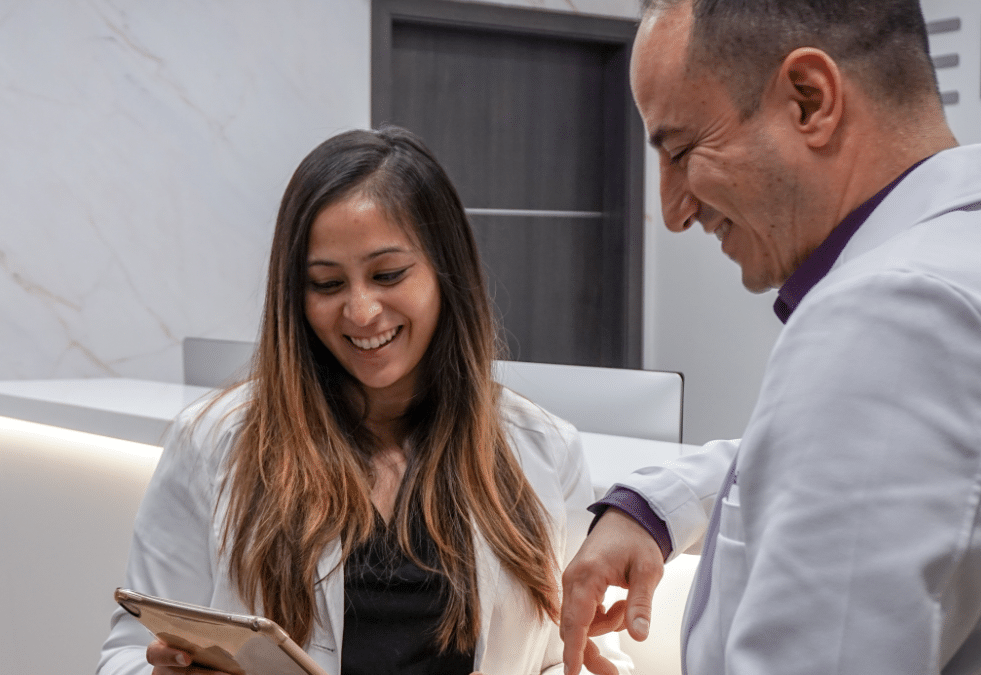Step 1: Booking an Appointment
Vein Treatment Clinic is widely recognized as the best medical center for varicose vein treatments near SD. That might sound like an overstatement, but it’s backed by 5-star ratings and reviews from patients, evidence of our perfect track record. One of our recent patients said, “I am thrilled with my results from vein treatment! Virtually painless and no side effects. The entire staff and doctors are incredibly professional and passionate. I would definitely recommend the Vein Treatment Clinic. Thanks to all. Special thanks to Dr. Koo and Dr. Billy.”
The primary reason for our excellent reputation and track record is a comprehensive vein care approach. Our board-certified and fellowship-trained vein doctors diagnose and treat the root cause of your vein problems, ensuring optimal and lasting results. Most medical centers only treat varicose veins and spider veins, even though they’re usually symptomatic of chronic venous insufficiency. However, our vein doctors always identify and treat the underlying condition to prevent a recurrence. If you want a comprehensive varicose vein treatment, please consult our vein doctors to discuss your options.
Vein Treatment Clinic is a state-of-the-art and accredited vein center located at 5330 Carroll Canyon Rd Suite 140. It’s in a beautiful neighborhood called La Jolla on the outskirts of San Diego, a short distance from the nearby Torrey Pines beach state park. We also provide free insurance verification before the appointment — this allows us to provide a complete breakdown of your vein treatment costs during the appointment. Please schedule a consultation online or call us at +1 858-461-7886 to request free insurance verification.
Step 2: Consultation & Diagnosis
During your initial consultation, the vein doctor will understand your unique concerns and goals. The primary goal of the consultation is to determine if you have underlying chronic venous insufficiency, which, in turn, allows the vein doctor to curate a personalized vein treatment plan. The vein specialist examines your leg veins, discusses your symptoms, reviews your medical history, and runs advanced vascular imaging tests.
- Visual Examination: The vein doctor examines your leg veins, including your varicose veins and spider veins, to determine if you have other signs of vein disease. The physical examination also reveals the extent of your venous insufficiency.
- Discussion of Symptoms: The vein specialist asks if you experience leg heaviness, frequent leg cramps, restless leg syndrome, leg pain, and leg swelling, with worsening intensities at the end of the day or after long periods of sitting or standing still. These are some of the earliest symptoms of venous insufficiency.
- Vascular Imaging Tests: Doppler Ultrasound is an advanced vascular imaging test wherein the vein doctor uses ultrasound technologies to project a visual image of the blood flow in your leg veins on a computer screen. The direction of the blood flow conclusively reveals if you have venous insufficiency.
Step 3: Treatment Planning
The vein doctor discusses your vein treatment options after identifying the diseased saphenous vein responsible for your varicose veins and spider veins. They explain what you can expect from various varicose vein treatments, including their pros, cons, costs, and insurance coverage options. If you provide your insurance details ahead of time, the vein doctor can also provide a detailed breakdown of the vein treatment costs with insurance coverage. As such, our vein specialists ensure complete transparency — you have all the information necessary to make an informed decision.
Step 4: Primary Treatment
The “primary treatment” refers to the minimally invasive varicose vein treatments that address the root cause of your vein problems — chronic venous insufficiency. Minimally invasive vein treatments have the same underlying goal — collapse or destroy the diseased saphenous vein responsible for your vein problems, restoring effective blood circulation to the heart. But they achieve that goal through different techniques, such as thermal energy, laser energy, or medical adhesives.
- Radiofrequency Ablation: The vein doctor makes a small incision on the skin’s surface, inserts a catheter into the diseased vein, and activates it to generate thermal energy, collapsing the diseased vein.
- Endovenous Laser Ablation: The vein doctor makes a small incision on the skin’s surface, inserts a laser fiber into the problematic vein, and activates it to generate laser energy, destroying the affected vein.
- VenaSeal: The vein doctor injects a medical adhesive into the diseased vein to fuse its walls and make the accumulated blood reroute to healthier leg veins. The diseased vein eventually gets absorbed by the body.
Step 5: Cosmetic Treatment
The “cosmetic treatment” refers to the minimally invasive procedures that remove the superficial varicose veins and spider veins without addressing the underlying vein disease. As such, the cosmetic treatment is suitable for patients without underlying venous insufficiency or after the primary vein treatment. Ambulatory phlebectomy and sclerotherapy are the best minimally invasive cosmetic treatments.
- Ambulatory Phlebectomy: The vein specialist makes small incisions on the skin’s surface to manually extract the superficial varicose veins. The incision marks eventually heal into scars that fade away.
- Sclerotherapy: The vein physician injects a sclerosant solution into the spider veins, turning them into hardened scar tissues that get absorbed by the body. The spider veins eventually fade away in a few weeks.
Step 6: Recovery & Aftercare
Minimally invasive varicose vein treatments are in-office and outpatient procedures. They conclude within 30 to 60 minutes with no downtime. As such, you can resume all your daily activities and work as soon as you leave the vein clinic. However, you must observe the following recovery guidelines:
- Don’t lift heavy objects for a few days.
- Wear compression stockings for a few weeks.
- Avoid sitting or standing still for long periods.
- If you have a desk job, take short walking breaks every 30 minutes.
- Elevate your legs while sitting down, if possible.
- Engage in cardiovascular exercises that work your calf muscles — running, swimming, cycling.
